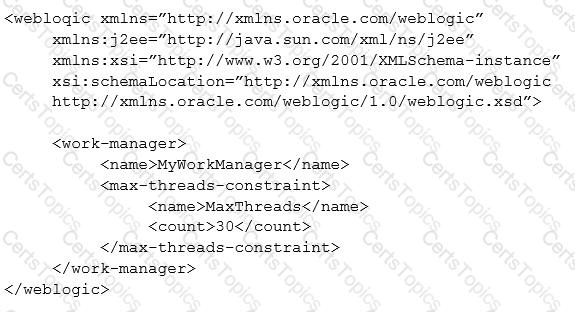As the WebLogic domain administrator, you have been asked to create a new cluster and to establish load balancing of JMS destinations across multiple servers for this cluster.
Which three configuration options will ensure load balancing of distributed destinations? (Choose three.)
Which two objects can be considered potential clients of a Node Manager? (Choose two.)
You are responsible for creating scripts to use Node Manager with a WebLogic Server domain.
Which four statements correctly describe the WLST command: nmEnroll? (Choose four.)
A Web Module needs specific tuning. The Development team fine tunes the module in the deployment descriptor (weblogic.xml) as follows:

Which two are true? (Choose two.)
You are required to configure SSL for an instance of WebLogic Server in a production environment. You have already created your self-signed certificate within the myKeyStore.jks keystore. You must now obtain a new digital certificate from a trusted Certificate Authority.
Which command do you use to start the process? (Choose the best answer.)
Which statement is correct for JTA service migration? (Choose the best answer.)
You are managing and monitoring durable subscribers for your JMS topics to ensure that all the subscribers would receive persistent messages.
However, JMS connections are currently restricted, so only one connection with the same client ID could exist in the scope of your cluster.
On which page of the Administration Console can you set Client ID Policy to unrestricted in order to lift this restriction? (Choose the best answer.)
Your clients are connected to distributed destinations to consume messages sent to various JMS topics.
Recently, JMS connections got interrupted due to a network failure and your clients dropped their connections as well.
How would you ensure seamless failover for your clients when a distributed destination fails? (Choose the best answer.)
You are implementing leasing functionality within your environment to ensure exclusive ownership of a cluster-wide entity.
Which type of leasing requires that Node Manager is configured and running? (Choose the best answer.)
You are developing and managing distributed destination applications for which you do not need to create or designate destination members.
Which configuration steps in the Administration Console will help you to create and target a Uniform Distributed Topic so that you can rely on WLS to create the necessary members on the JMS servers to which a JMS module is already targeted? (Choose the best answer.)
Coherence is integrated with WebLogic Server in the form of managed Coherence servers.
What two options are immediate benefits of running Coherence on WebLogic Servers versus as standalone servers that are not part of the WebLogic domain? (Choose two.)
You are considering targeting your JMS servers to dynamic clusters to benefit from dynamic scaling. However, you have been advised to keep in mind some of the associated limitations.
What are two valid limitations and considerations for clustered JMS services? (Choose two.)
Your WebLogic domain consists of deployed applications heavily relying on JMS. Three machines, each hosting a managed server, are part of a cluster.
In order to ensure the availability of servers and JMS service on those servers, you are considering the configuration of whole server migration rather than service migration.
Which two statements are prerequisite for whole server migration but not for manual service migration? (Choose two.)
You are using the Domain Template Builder to create a new template using an existing domain as the source.
Which two directories are included by default? (Choose two.)
Review this scenario of an application running on a storage-disabled, managed Coherence server that uses a Coherence two-tier near cache:
Assuming this is the server’s first access of this data from the cache, how many network round trips between Coherence cluster instances take place in total? (Choose the best answer.)
You are troubleshooting an application that uses a WebLogic server data source. You decide to execute a reset() operation on the corresponding JDBCDataSourceRuntimeMBean.
Which statement is true regarding the impact on the application that is using that data source? (Choose the best answer.)
You are monitoring a WebLogic JDBC data source and have decided to drop some connections because an earlier peak usage condition has now ended. In addition, this data source has not been enabled for automatic shrinking.
What will occur once you execute the shrink() method on that JDBCDataSourceRuntimeMBean?
You have enabled JMS Diagnostic Logging and are analyzing JMS Message delivery and acknowledgment using the generated log entries. For this purpose, you are tracking individual message IDs.
What is the default format of the message ID that you would expect to see in the log? (Choose the best answer.)